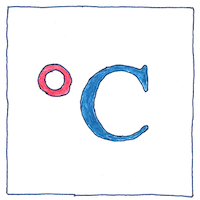Anders Celsius, Jean-Pierre Christin
thermometry

|
Centigrade scale
Anders Celsius realized the need for a standard temperature scale based on two scientifically reproducable points. He showed that the freezing point of water was independent of barometric pressure and that the boiling point could be calculated given the difference from a standard barometric pressure. Celsius placed zero at the boiling point of water and one hundred at the melting point of ice and named his scale centigrade meaning “one hundred steps.” Independently of Celsius, Jean-Pierre Christin created a temperature scale using the same points but placed zero at the melting point and one hundred at the boiling point. It turned out that the French and Spanish use the word centigrade for one ten-thousandths of a right angle, so in 1948 international committees renamed the scale to honor Celsius.
Metric degrees
Having a hundred degrees between melting and boiling the Celsius scale makes sense to have become adopted as part of the metric system.
Arbitrary decisions
The scales of de Réaumur and Celsius went backward, where the temperature got smaller as things got hotter. Having a decision can be more important than what the decision is. It would be good if we were all on the same wavelength; however, things can be arbitrary and people do not like to change frequency. “To an arbitrary degree” has a sound that rings true, somewhat like our weather forecasts. Someone may be experiencing 20 °C nearby; however, where we sit, the air is balmy.



Properly speaking, we are not talking about the centigrade scale here; we are talking about the Celsius scale. I use the retrograde term only because it is the term that Anders Celsius used.
See also in The book of science:
Readings in wikipedia:
Other readings: